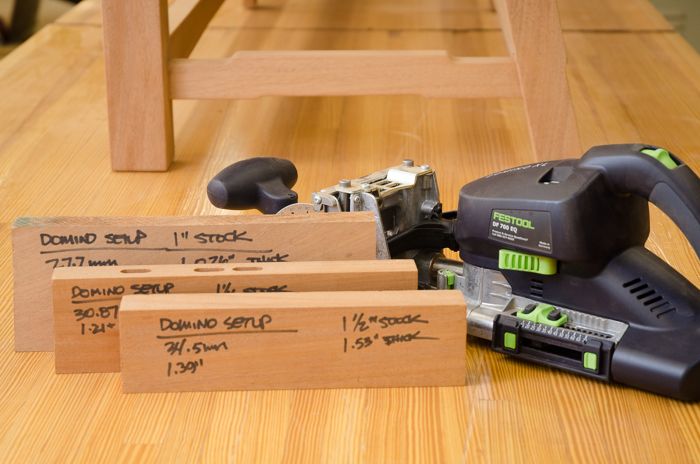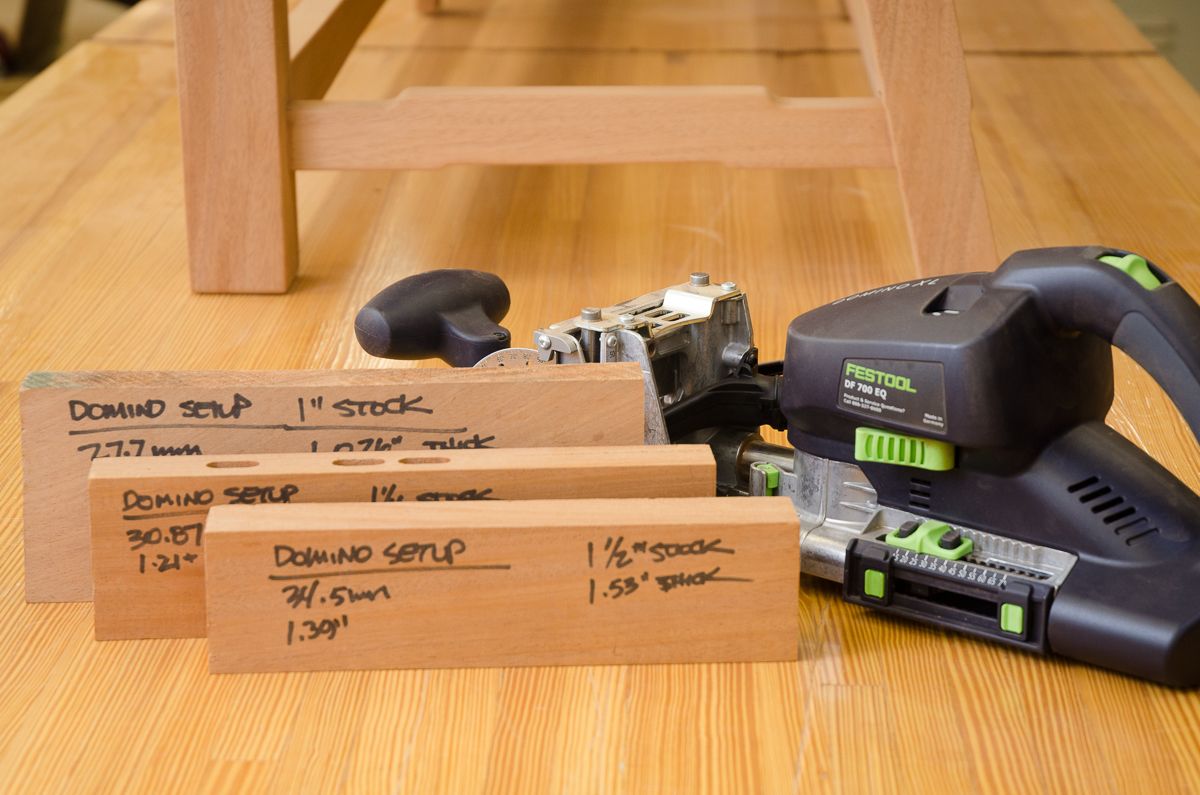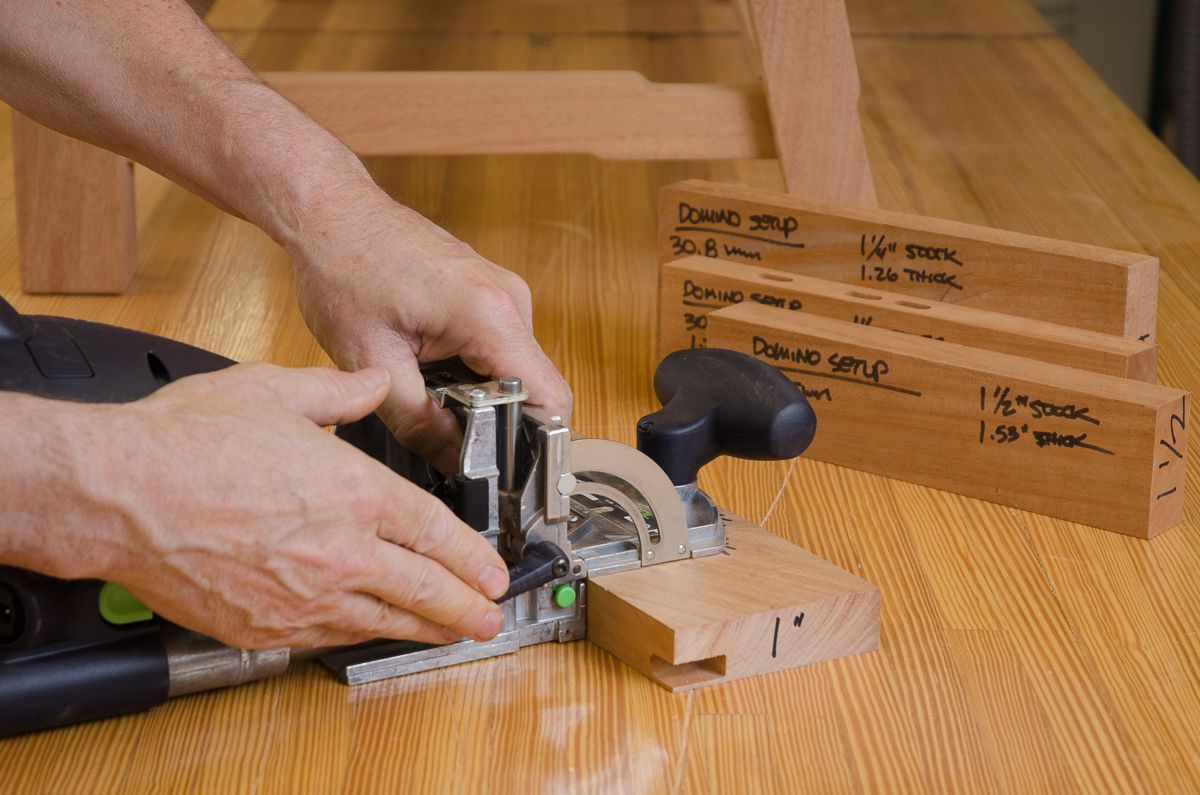Centering the Festool Domino on Imperial Based Materials
Furniture maker Tim Celeski uses a set up custom-made set-up gauges to get around Imperial vs. metric measurement issues with the Domino system.

Furniture maker Tim Celeski uses a set up custom-made set-up gauges to get around Imperial vs. Metric measurement issues.
The Festool Domino is certainly an extremely useful tool for furniture makers. Both the DF 500 and DF 700 are great for making joints quickly and accurately. The DF 700, with its ability to make and use larger sized mortises and tenons, particularly stands out for furniture making.
But when I put the tool into use in my shop I quickly found a major problem. As a U.S. based furniture maker all the parts I make are Imperial (inches) in their measurements rather than metric based (millimeters). Both the Domino DF 500 and DF 700 are metric based. Though this is not a problem when it comes to the joints and tenons themselves in terms of mortise and Domino width, thickness and depth, it is a major issue when it comes to stock thickness. Both of the Dominos stepped height gauges are in increments like 15, 20, 30 mm, etc. But, when my furniture parts are 3/4″, 7/8″, 1″, 1-1/4″, 1-1/2″ etc., those metric settings on the height gauge do produce quite a problem.
The reason is this: Though, I often offset a stretcher’s position on its mating piece like a chair leg or table apron for visual relief I usually prefer to center the tenons on my stretcher’s thickness for parts used in tables, chairs, stools, etc. This allows me to maximize the stretcher’s joint strength on what is often a small part and gives me flexibility in how the parts can be used in different situations –rotating and flipping parts for example. Plus, by being precisely centered on the part’s thickness it increases the accuracy and consistency of the parts and makes it much easier to deal with angled stretchers.
The problem is that there’s no easy way to reliably setup up a Domino so that it centers on an Imperial sized piece every time. The Festool Domino Height Gauge is set for metric based stops measured from the center of the bit from 15 to 50mm. Setting the gauge manually, rather than using the stops will inevitably lead to inaccuracies.
Festool says that it shouldn’t matter as long as you make your mortises on the same side of both boards. Technically this is true and it’s always a good practice to do this but there’s many situations in woodworking where centering a mortise is necessary–especially when it comes to stretchers which tend to be thinner parts. Why not start with a solution that centers your mortise every time? So, how do you center the bit on a 1″ board for example?
After scratching my head for a while I came up with a fairly good solution that works for both the DF 500 and the DF700. I made up a set of special sized setup gauges that I use by setting the tool and the gauge on a flat surface and set the fence to the top of this setup block. The result is that the bit is centered on my Imperial based stock.
To make up setup blocks you need to mill up a piece of scrap to 15mm (the height from the base of the tool to the center of the bit plus 1/2 of the thickness of the board thickness you want to be centered on. For example, to center on a 1″ board make up a setup gauge that’s 12.7mm (1/2″) plus 15mm for a total of 27.7mm (1.0926″). Yes, that’s getting pretty precise for running through a planer. A thickness sander might help you fine tune the dimensions. In any case you need to use a precision micrometer to check your work. Measuring metrically is a little easier, too. So, plan on doing lots of testing so that you can verify that your setup boards are accurate. Once you can take two boards of the same thickness put a Domino in the mortise then flip one of the test pieces over and if the boards are flush you know that you’re there.
To give you the dimensions for a setup boards I’ve included the chart below…
Festool Domino Set-up Boards
| Thickness of Stock | Set-up Board MM | Set-up Board Inches |
| 1-in. | 27.7mm | 1.0926-in. |
| 1-1/8-in. | 29.29mm | 1.15-in. |
| 1-1/4-in. | 30.88mm | 1.21-in. |
| 1-1/2-in. | 34.05mm | 1.342-in. |
So, how well does this setup board solution work? Quite well, actually. I use these setup boards on a daily basis in my furniture making. But, there is an even more elegant solution. A small company-Seneca Woodworking-makes add-ons and special parts to help with using both the Domino 500 and 700. They make special shims and height gauges for these tools which I’ll cover in a follow-up post here at FineWoodworking.com.
Check out the gallery below to see photos of how the centering setup works.
More from FineWoodworking.com:
- Video: How to use a Festool Domino
- Video: Get Perfect Reveals with a Domino
- Festool Domino accessories for Imperial Woodworkers










Comments
Well, I have used a TS-55 for years and have had no problems with the metric scale on it. You get used to it.
I suggest we all do the same for any metric tool.
Here in the U.S. we are luddites to continue with the 'Imperial' (who's toe was it?) system.
Our politicians - as usual - have no guts to change.
So like Jerry Work - we ourselves need to lead the change. How about FWW changing over to metric as the primary measurement, with Imperial as the secondary?
Lets ditch once-and-for-all 1/128 1/64 1/32 1/16 1/8 etc. Arghhh!
I agree with cahudson42; the change to metric is easy once you commit to it. Essentially all of my measuring tools from tapes to digital micrometers read both scales, but I rarely have to resort to the Imperial scale. I find that if I design in metric then all of these types of gyrations that Tim Celeski is writing about become superfluous. Start metric and stay metric. When you mill your stock, don't shoot for 3/4", but 19mm or instead of an inch make it 25mm and move on. No, these are not exact conversions, but visually they are close enough to being the same thing that it will not materially affect most designs.
The math with the metric system is just soooo much easier! If you have to divide a board that is 19 3/8" into, say, thirds it's a bit of a strain (for me anyway), but the same board is 492mm long and now it's easy.
Also, since the mm marks are closer together than the 1/16" marks on a rule I find the metric system to be inherently more accurate.
What are the chances the FWW will move to the metric system? I'd like it if they do, but I doubt that it will happen anytime soon. Still, I support the concept.
Why don't you go metric in U.S.A?
Let's have a debate in Fine Woodworking about this.
Greetings from Australia.
Wish we could buy Festool products at U.S.A. Prices
Yee Haa ~ whatever gave the impression that it's an 'imperial world?' The Yoo Ess Ayy's wedding to imperial is antediluvian and practically unique i.e. naked trade barrier. I say sooth when I observe the rest of the World is metric, the SI system ~ ever heard of it?
The problem might also be somewhat "reduced" if you buy the imperial gauge replacements for your Domino from Seneca Woodworking. I think Festool might void your warranty though.
There are only three countries in the world that have not officially adopted the SI (System International). Those countries are the United States, Burma and Liberia. A search of 'SI' in Wikipedia is a good read.
I vote for the change to metric. Sometimes I just use it because it is soooo much easier to do the math. Just recently, measuring for Blum drawer slides, it was easier to just go with their instructions and go with millimeters. Just make sure you buy rulers that also have metric.
Australia converted to metric in the 1960's I urge USA to now catch up with the rest of the world. The metric system is so much easier. All you need is a tape that is graduated in both systems and you have a ready metric converter for use when changing information either way. Trust me, it's great. As someone who was trained in both systems from school (I studied both Chemistry & Physics, where all readings were metric) I had little trouble anyway.
I imagine that USA schools also teach science subjects in metric, so there should be quite a number of people there familiar with it.
Cheers,
Ian.
The United States led the world in science, engineering, medicine, innovation, etc. for the last 150 years. Change? I think I'll stick with what has worked for me since childhood. Metric is 'easier'? It's all relative, numbers, math. BTW, didn't we win the war?
Every body seems to think that every thing from EUROPE is the greatest thing since American invented sliced bread. Euro hinges, Eurocar (GM) , wine , cheeses, etc...... If metric is so great and every thing is divisible by ten, why are there things measuring out in less than full mm... Left over tools and parts from my motorcycle days have many things that were less than any full numbered mm IE: tap and die for 6.4mm. Leave it to hell alone, go to Woodline Router bits and get what they call - "under and over size" bits to use the plywood that is out there. As with many things happening in this country today, I am glad I am 80.. Like the Scotsman says; "WE WON the war didn't we?"
Yes, MacGregorWoodWorks, we led in science, medicine, etc., but using the metric system. We are also now using metric for autos, and some other engineering and manufacturing in the US.
Back in the 70's, I was against the switch to the metric system ... I had already learned the imperial system and saw no need to change. Now, I wish we had done it years ago.
The problem I have now is finding some metric tools, especially drill bits. I long for the day when I go to the local home center and pick up a set of metric brad point bits. Yes, I know I can order them, but I'd rather be able to buy local.
I grew up with Imperial in Australia and lived through the change to metric. Given my struggles with fractions, I embraced the metric system and it was good to be rid of Imperial measurements. Even my father, a master joiner but who didn't believe in change if 'if it wasn't broken' switched to metric within a month or so when he worked out how the metric system reduced measurement errors in his business.
There's lots of America that has informally switched to metric - its armed forces, its airline manufacturers, its space program, its high end manufacturing, its science and so on.
But it seems to me that it is the US construction and woodworking people are the ones clinging on to the British Imperial system.
Why does US currency use a metric system and not the Imperial system of pounds, shillings and pence?
Why all the fuss? Note I do not own a Festool Domino so my comments are as a theoretician not a practitioner.
Since most furniture building ends ultimately in leveling or shave to fit it makes no difference if one sizes stock to Imperial or metric dimensions. WagoRranch has it right sizing to nominal metric makes setups with the Euro-centric Domino trivial. I do wish the US had migrated to metric measurements--life would be so much easier. We studied the metric system in elementary school (back when Sputnik was a new thing) and were expecting the US to soon convert. I am a scientist and an engineer and except for cooking (that's another place that needs conversion) much of my work is in both metrics and imperial. I flip back and forth with only occasional confusion. We spectacularly lost a Mars mission because one group calculated trajectories in metric--the recipient of the data assumed imperial dimensions.
I agree with cahudson42 --our politicians have no gumption, foresight, or fortitude.
I mill flat and square and after hand planing out the machine marks it matters little if my digital caliper is set to Imperial or metric for target dimensions. My AutoCad easily dual dimensions drawing measurements. If the alternate dimension is fractional it will round to the desired precision. I expect Sketchup has similar capabilities. I would like FWW to take a lead and present some metric-nominal designs.
--DKH
Take it from an elementary school teacher and machinist metric is the way to go. The unit on fractions takes weeks. We can become "experts" in using the metric system in less than a week! As a machinist I never deal in fractions without immediately converting to decimals. We should utilize metric and save everyone a lot of headaches.
I think maybe we have gotten a little off topic. the author isn't debating metric vs. imperial, and he can't just "switch over" to metric.
He is using a metric tool to machine wood that has imperial dimensions, and has created his own workaround.
I just bought a Domino 500 & immediately had the same problem. Measuring the wood with a metric caliper and then setting the fence as close as possible to half that dimension I still end up a little off - that's fine if none of the pieces gets flipped during assembly.
In my case I bought the Seneca Woodworking imperial fence guide & replaced the stock one. Now my mortises are dead center in nominal thickness dimensional lumber.
Personally I wish Jimmy Carter would have pushed us to make the switch back in 76. The reason that it failed was that there was a long transition period for people to "get used to" metric, and that created too much confusion in people trying to "convert" one way or the other.
If we had just switched and thrown imperial out the window I don't think the public would have had near the trouble thinking decimally at all.
This article actually is about metric vs imperial. Growing up in Canada I'm well versed in metric and it has it's benefits. But it also has it's problems. Essentially it boils down to base 10 or base 12 math. Base ten has huge limitations with it comes to whole number division which is a problem for wood workers. My conclusion is that metric was made for the lab not for life.We live with base 12 every day on our clocks and calendars. Anyone who can 'tell time' knows fractions, so the bluster about explaining fractions is overblown. Besides, since when is dumbing down a virtue? Same applies to using the Domino--figure it out. Perhaps the aversion is to learning a new language and becoming bilingual.
I read all the comments, and much like the article, they focus on the metric vs Imperial debate. Regarding the Domino, after reading the full article in FWW, I would like to recommend people go back to FWW#174 and read about the homemade slot mortiser. While not as small or portable as the domino, it can do as much or maybe more. It is one of my most used jigs/tools and costs next to nothing compared to a $1000 domino. I wish I'd made mine years earlier as it has simplified and improved my woodworking immensely.
I agree with msdr's comment. Check Greg Paolini's website for an updated version of the 3-axis slot mortiser described in FWW 174.
Being British I use the metric system as this was introduced in 1972. I can use the old Imperial system and do so as I work in the oil industry and much of the pipe sizes and threads are in inches.
Fact is though that the metric system is simply easier and far more integrated. 1kg = 1 ltr = 1000ml. 1000ltrs = 1m3 = 1 metric tonne or 1000kgs. This is equal to 1000mm x 1000mm. It all fits together as a system extremely well. And that is why even in the US metric is used in many industries and in research institutions. If you have ten fingers (not always true of a woodworker, I agree) you can work easily in metric.
Most of all though the entire world outside of the US uses it and that presents a problem for US industry and young people. The US was and to a large extent still is the powerhouse of the world. Not only that the US lead the way in many areas of which is should be justifiably proud. To hang on to an outmoded ancient and unwieldy system that holds back the education and manufacturing seems obtuse.
Mind you, Fine Woodworking and the creations within are still the best I've ever seen. That's why I pay the extra to import the magazine. Simply excellent stuff.
Just to follow-up on my previous comments about the Slot Mortiser: I am making some cabinet doors and had to cut mortises yesterday. The doors will have 84 floating tenons in total, which meant 168 mortises, all 3" long and just over 1" deep. It took me less than 2.5 hours, and they all fit nice and flush. I can't imagine a domino would be any quicker or more accurate, and here in Canada, Lee Valley sells them for over $1600. That's a couple routers I could buy for the price of one specialized tool. I've never regretted building that slot mortiser. Plus I just rigged it for dust collection and that has saved me even more time (and clean-up).
Wait - Festool - isn't it a German company - why would they make a product for a market that was so small (ie the US) when the vast majority of the world used the metric system.
Metric is the way forward we are getting left behind in so many areas - after 30+ years since the US started to use teh metric system what do we have to show for it - the 2ltr bottle of coke...
having grown up in the UK I am fluent in imperial, metric and whitworth (check British Standard Whitworth) metric is so much easier to deal with try finding the middle of a board 3-3/8 wide. But find the middle of 66.68.
I just bought a saw stop and all the instructions are in mm and the glide scale in cm/mm I was so happy.
I have the Domino DF 500. I decided to try out the setup blocks. I found that the information in this article may be fine for the 700 XL but the 500 has an offset of 10mm, not 15mm. Make sure you take that into account when you make your setup blocks.
Why do you need your mortises centered so precisely? If you want the top surfaces to line up, select the top face of both boards and keep that surface up as you make the mortises. I can get close enough to center using the height gauge (not the board thickness presets) without worrying about joint strength or how many atoms, cubits, parsecs or leagues can fit in the difference.
Worry about your plunge technique instead. Resist the temptation to grab the Domino around the power switch area and slam the bit into the board while making your plunge. You can easily tip the fence slightly during the cut when trying to plunge this way. Try plunging the Domino with just the fingertips touching the Plugit end and take at least 10 seconds to make the cut. Concentrate your attention on the other hand and keep both fences firmly in contact with the workpiece.
Don't buy Festool. They are an unAmerican company that engages in price fixing. Buy from some other company.
Log in or create an account to post a comment.
Sign up Log in